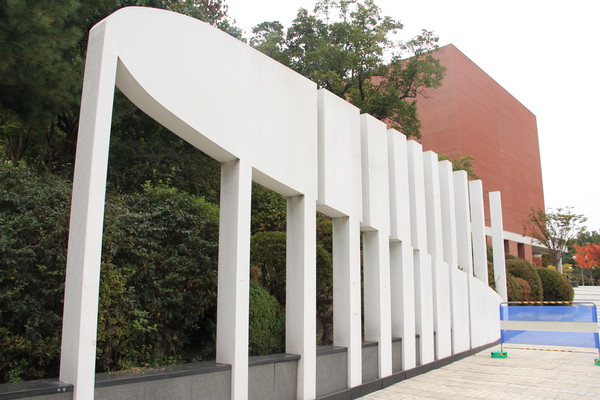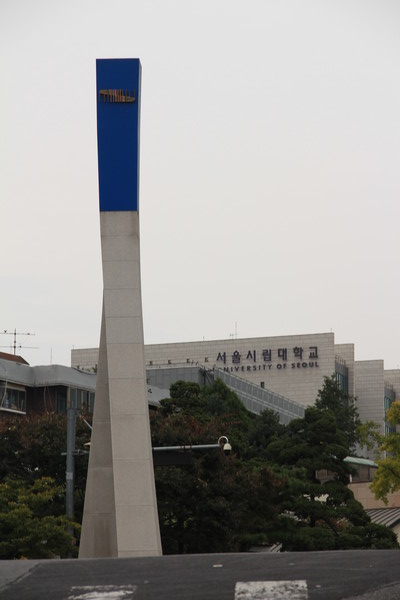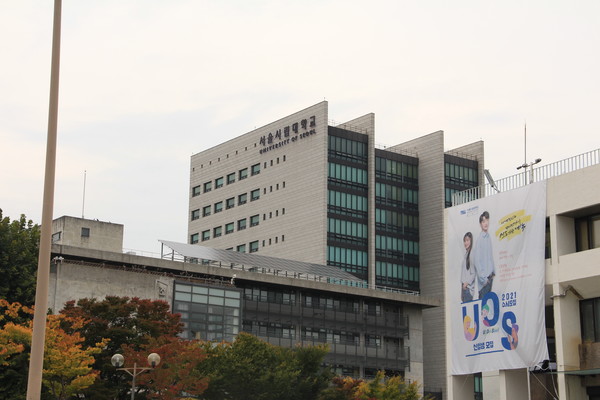
“Just do it.”
The shape of an apple; bitten on the right side.
“I’m lovin’ it!”
The UOS Times knows what you thought of right after reading this quote, explanation of a logo, and catchphrase. The images of Nike, Apple logo, and McDonald’s advertisements may appear in your mind. How did that happen? This is because the aforementioned slogans are so closely related to their company characters that anybody can connect to what they represent. You may say it is merely because the companies are already famous enough that everybody may have heard of them more than once. Although that may be true, it is more than just because of fame. In fact, it is all about “branding.” “Branding” is significantly important for universities as much as it is for companies.
On September 9, 2020, University of Seoul (UOS) had decided to shut down all the university promotional logo song videos organized by JTBC and UOS Division of Planning Affairs. These were eliminated from UOS’s official YouTube channel, and every digital advertising that was placed outdoors, including the subway, was withdrawn. Some students commented with negative feedback, and one student even submitted “총장에게 바란다 (A Request to the President, in English)” to demand an explanation about the low video quality. UOS explained that they had to cut off some important parts of the video because there were negative issues with one participant. However, although the plans for videos were critically affected by issues regarding one participant, they cannot deny the fact that the quality of videos frustrated students’ expectations. Why were students so upset even though the videos were simply promotional videos? The answer is that contents of the promotional videos failed to represent UOS character and brand as examples above.
Why is promoting a brand so important for a university? The UOS Times was curious about what students were thinking about UOS, what UOS missed in university promotion, and what UOS can publicize to emphasize the strengths of UOS. Therefore, The UOS Times conducted a survey from Sept. 29 to Oct. 2 with UOS students. We tried to find answers to such questions through the following survey:

Question 1) Do you think UOS promotes the school well?
In all, 19.6 percent answered “yes” and 80.4 percent answered “no” to this question. More than half of the respondents said that UOS did not promote the school well.
Question 2) Do you think UOS has clear images?
In all, 56.9 percent said “yes” and 43.1 percent said “no” to this question. For further discussion, the following questions were:
Question 2-1) If you said “yes,” what images do you think UOS has?
This question was a short-answer question. A total of 40.6 percent responded that “tuition is cheap.” The UOS is the only university in South Korea that implements a “half-price tuition” policy. According to the “2019 Average University Tuition Status” report by the Ministry of Education, the annual average tuition of domestic universities was KRW 6.44 million and for UOS for 2020 it is KRW 2.61 million. The registration fee is less than half of the average tuition of domestic universities. However, few respondents expressed that “tuition is cheap.” They used the wording “Coupang University” as a comparison to a company with the same name that markets at a half-price discount regularly. This is based on the stereotype that if the price is low, the quality of offered goods and services will also be low. The answer reflects the consciousness that the UOS should tout clear images except for tuition. This will be further analyzed in questions 4, 6, and 7.
The percentage of those who presented positive or negative UOS perceptions was recorded at 21.8 percent for each group, respectively. Respondents who suggested positive images said “faithfulness,” “goodness,” and “hard-working students.” Negative image suggesters answered “low activity participation,” “poverty,” “minority,” and “short history.” Several students also answered neutral images, such as “public officials,” “city or public characteristics,” and “an institution belonging to Seoul-city.”
Question 3) Which areas do you think the promotion of UOS mainly emphasizes?
This question allowed multiple choices. In all, 88.2 percent answered “tuition.” “Output of examination” was the second, chosen by 25.5 percent of the respondents, followed by the “campus” (13.7 percent). “Academic research performance” was the response of 5.9 percent, while 8 percent of students replied that they had no idea.
The UOS’ “Half-price tuition” is significant merit for students who pay their fees. Therefore, respondents said that UOS seems to be doing well at promoting low tuition. However, some students did have negative thoughts about overstressing the registration fee. Student A says “I once participated in the admission explanation session before I got in. I felt like the speaker talked too much about tuition.” Some students may think that the UOS ought to use other strengths for publicity; this will be covered in question 5.

Question 4) Except for tuition, on what else can UOS appeal its strength in promotion?
As seen from the answer to question 3, students think that tuition takes almost half of the pie in the university promotion. As it is the best advantage of UOS, The UOS Times wanted to know what else the university can emphasize except it. This question allowed multiple replies. The most voted were Output of examination, including Law school, Public Officer Qualification Exam, Certified Public Accountant (CPA), and so on. Almost 7 out of 10 students voted. In fact, UOS takes the lead in various examinations despite a small number of students. This is usually an important category to estimate the quality of university, and students thought UOS should appeal more to this. The second largest pie was “Campus,” and 52.9 percent of participants voted. UOS is famous for its beautiful landscape and flat campus. As UOS is well-known for the Dept. of Landscape and Architecture, the campus is peaceful and eco-friendly. Some of our campus buildings have won prizes from Seoul and the Ministry of Education. Third and fourth were in the order of “Academic Research Performance (47.1 percent)” and “The Faculty” (41.2 percent). UOS is striving to follow the trend by founding new departments (Dept. of Artificial Intelligence and Dept. of Cross-disciplinary Applied Chemistry, working title) and for the high quality of research by setting the “Integrated master course program.” Others were in the order of “Graduate Employment Rate” (33.3 percent), “Alumni” (11.8 percent), etc.
Question 5 is meaningful because it helps to precisely examine students’ thoughts about UOS advantages and what UOS is missing out on in terms of advertising. Moreover, universities can use them for future promotion.
Question 5) Do you think UOS utilizes the school’s advantages well for the promotion?
In all, 31.4 percent replied “yes,” while 58.6 percent replied “no.” More than half of the respondents said that UOS does not fully take advantage of the school’s strong points. Thus, we asked the following questions:
Question 6) What do you think is insufficient in the university promotion?
Even without low tuition fees, students thought UOS has many other advantages and can use them in promotions. However, it is a different story from the university that actually promotes good promotions. In this question, “UOS is overemphasizing its low tuition fee” was the most answered. In addition, “No slogan (catchphrase),” “no concept no character,” and “inactive in university promotions” were the most common four replies. It is doubtful that UOS is making use of many other advantages as students answered in question 4. We will determine what can be changed and should be more reinforced.
Question 7) Feel free to mention any other promotional cases you would like to suggest UOS to follow.
1) Mascot (1st)
We have already dealt with this issue so please refer to: First Step in Making the School Image: Mascot https://times.uos.ac.kr/news/articleView.html?idxno=10065
2) Strategy (2nd)
It is true that a low tuition fee is an advantage for the student. However, as we can see in question 2, the low tuition fee had a negative effect on promoting UOS. The UOS Times thinks this may be related to the quote: “Too much is as bad as too little.” Lowering tuition fees was sensational when UOS decided to make tuition half-price at that time. It has become one of the best advantages of UOS that no other university has. This fact was used actively in many promotions. However, time has passed since then, and nothing has changed. UOS continues to place great emphasis on low tuition fees, and people got used to it. Even the cheap image covered UOS, and it feels like nothing’s left except for a low tuition fee. Tuition is fully promoted. To get rid of the poor image, it is time to change, and maybe it will be more attractive by not even mentioning it. This continues in:
3) Making Through Characteristics of the University (3rd)
https://www.youtube.com/watch?v=tQBZUSEhT1M&feature=youtu.be
Did you notice that this promotional advertisement did not even mention its product? The mood of the video and the catchphrases are far from the actual product. However, anyone watching this video can understand the purpose, feeling, and motive that is ultimately being sought. This makes consumers have an interest in the company and lead to buying the product, which can directly apply to university promotion. Like companies, the university should brand itself. To do so, UOS should know exactly what their strength is, what factors about UOS can appeal to high school students, and lastly, make the school image properly. This process will naturally build up the university’s character. It involves the 4th and 5th most commonly answered replies: “Making University Goods” and “Making Catchy Slogans & Good Promotional Videos.”

According to the survey, most UOS students want to change the school’s advertisements because they think they do not work well. Students said that it is important to make good use of the school’s strengths. To improve the shortcomings of publicity, students want to create a mascot. Moreover, they wish to establish images that would appeal to high school students rather than emphasizing low tuition, which could be a double-edged sword for the school's impression. Making university goods and slogans can be an alternative to achieving these goals.
Students may have a love for UOS while being in school, but it is important to give the impression that UOS is a good university even to those who do not belong to the school. Fortunately, students are willing to make efforts to better promote UOS. Therefore, the UOS should listen to the students’ voices and strive to make favorable images through sophisticated promotions.

